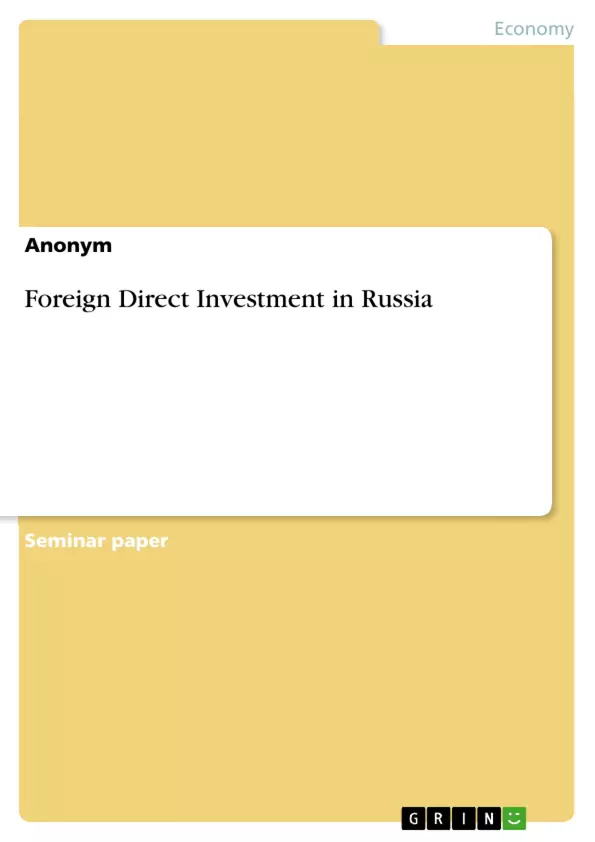Foreign direct investment constitutes a highly important part of contemporary world economy. Globalization of international economic relations have led to the situation in which many countries face the necessity to compete with each other and, thus, to enhance their competitiveness through attraction of foreign capital. FDI in this respect appears to be the most desirable option for many economies, as they are more stable than other forms of investment.
This papers answers the question of why Russia attracted such a small amount of FDI since the beginning of the transition process. This analysis takes into consideration major determinants of FDI inflow to the country as well as factors of their spatial and sectoral distribution within the state.
Inhaltsverzeichnis (Table of Contents)
- Introduction
- FDI during the period of transition: a failure or success?
- Spatial and sector distributions of FDI in Russia
- Factors behind investment performance of Russia
- Conclusion
- References
Zielsetzung und Themenschwerpunkte (Objectives and Key Themes)
This paper aims to analyze the factors behind foreign direct investment (FDI) performance in Russia during the transition period, specifically focusing on why Russia attracted a relatively small amount of FDI since the beginning of the transition process. The paper will explore the determinants of FDI inflow, its spatial and sectoral distribution, and the impact of various factors, such as investment climate, on the effectiveness of FDI in Russia.
- The impact of FDI on transition economies, particularly Russia
- The relationship between FDI and economic growth, human capital accumulation, and productivity
- The role of investment climate and political stability in attracting FDI
- The spatial and sectoral distribution of FDI in Russia
- The effectiveness of FDI in Russia during the transition period
Zusammenfassung der Kapitel (Chapter Summaries)
- Introduction: This chapter introduces the concept of foreign direct investment and its significance in the global economy. It highlights the debate among researchers on the relationship between FDI and key economic indicators, particularly in developing and emerging markets. The chapter also emphasizes the unique challenges faced by transition economies, such as Russia, in attracting and benefiting from FDI.
- FDI during the period of transition: a failure or success?: This chapter examines the historical trends of FDI in Russia during the 1990s and early 2000s, highlighting the relatively low levels of investment compared to other countries and transition economies. It explores the reasons behind this low performance, including factors like political instability, unfriendly investment environment, and the impact of the 1998 financial crisis.
- Spatial and sector distributions of FDI in Russia: This chapter delves into the spatial and sectoral distribution of FDI within Russia, analyzing the factors that influenced the concentration of investment in specific regions and industries. It examines the role of regional reform progress, investment climate, and other determinants in shaping the pattern of FDI distribution.
- Factors behind investment performance of Russia: This chapter focuses on identifying the key factors that have influenced the overall investment performance of Russia, both positive and negative. It explores the interplay of various economic, political, and social factors, including macroeconomic stability, institutional framework, and the overall business environment.
Schlüsselwörter (Keywords)
This paper focuses on the key concepts of foreign direct investment (FDI), transition economies, investment climate, spatial and sectoral distribution, investment performance, and economic growth. It examines the impact of FDI on Russia's transition process and explores the factors that have influenced the success or failure of FDI in the country.
- Arbeit zitieren
- Anonym (Autor:in), 2006, Foreign Direct Investment in Russia, München, GRIN Verlag, https://www.grin.com/document/356292



